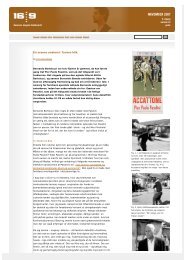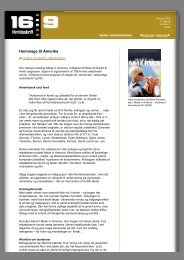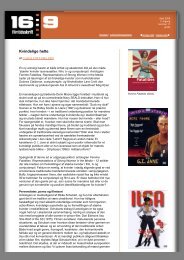letter's thoughts about his promise to return in two weeks: "How littleyou knew yourself. That train was taking you out of my life." It is as ifLisa is overflowing with words to express disappointment and regret.She can never come to the end of "If only..." But she has nothing to sayabout fulfilment [*11]. We may choose to understand herspeechlessness as an expression of the sense that rapture is beyondwords. But it is one of the functions of the pattern of repetition andreversal to open up other ways of responding.Lisa's silence goes with the absence of her witnessing foregroundpresence. It is a silence about her place in the stream of Stefan's loversas well as about the consummation of her passion. We may relate it toher presentation of her first disillusionment. What had Lisa learned fromthe sight of Stefan's mistress to persuade her that there was "nothingleft for me"? She already knew that many of his friends - most of them -were women. Staircase One already condensed <strong>som</strong>e significantrepetitions, of the staircase itself as the central emblem of the routinesof Stefan's life, of Lisa's overhead view of adult sexuality (when sheemerged at the top of the stairs to surprise her mother in embrace withHerr Kastner) and of Lisa's spying from above on Stefan's nocturnalactivity. This last was in continuity with the instances of the illicit(stealing, hiding) in Lisa's appropriation of Stefan's music into herfantasies when "though [because?] you didn't know it, you were givingme <strong>som</strong>e of the happiest hours of my life." Happiness in fantasyprepares the misery of disillusion not because Lisa finds out that Stefanis a sexual being, but because his timing is catastrophic for her. Theperfection of Lisa's romantic fantasy required Stefan to be ready for herat precisely the moment when she was ready for him, ready "to throwmyself at your feet, and cling to you and never leave you." For Lisa, asfor Stefan, the pursuit of perfection means a life defined bydisappointment.What is it that encourages me to talk of the absence of commentary onthe scenes of romantic fulfilment as Lisa's silence? We have tounderstand that the events of the past, insofar as Stefan is told of them,are recounted in the text of the letter. "Night after night I returned to thesame spot, but you never noticed me until one evening..." This must bea sentence that continues in the letter, whose continuation the film hasreplaced with images. Sensibly, then, Lisa is not silent about the eventsof Staircase Two - only unheard. But here I want to return to my start.Ophuls and Koch devised a form that baffles the attempt at a sensiblereading. My argument is that the intention, and certainly the effect, wasto create an unstable set of frames so that while a story is told, withevents whose occurrence is not to be doubted, the definition of theirsignificance is never pursued at the cost of suggestion. The film'slucidity is a lucidity in presenting ranges of possibility, through what itcan omit to specify as well as through what it can show.The refusal to confine flashback and voice-over within a coherentconvention gave the film access to the metaphorical possibilities ofthese devices, allowing the passages of speech and silence,explicitness and reticence, to register expressively. At the same timethere was a partial submission to limitations of viewpoint that seemedto assign Lisa a role in determining what was to be seen of her life andof Stefan's, so that opportunities were created for veiling motivationsand for leaving thoughts, feelings and attitudes open to speculation. Forinstance when Stefan comes to the photographs that Lisa has enclosedto stand as his son's biography, it is clear that he is moved by theseglimpses of a child he will never meet; his use of a magnifying glassspeaks of a hunger for knowledge that the snapshots cannot satisfy.But nothing tells us how far Stefan attends to Lisa's presence in one ofthese images. And when Lisa tells of her marriage and says that Stefanknows who her husband is, we are without guidance about the extent ofStefan's appreciation that this letter is from that woman whose husbandhas challenged him to a duel - the woman who, we shall shortlydiscover, came calling a few days ago after an encounter at the Opera.The masking of Stefan within Lisa's viewpoints is particularly powerfulin Staircase Two, for Stefan's attitude here is perhaps the most crucialissue in our sense of what is being repeated and what has been
transformed. We are shown that Lisa could be seen as just one in thesuccession of Stefan's women. We are not told whether Stefan seesher in that way. As a result we are given no hint about what Stefan'sresponse might have been if Lisa had been able to seek him out withthe news of her pregnancy after his return from Milan.Stefan's leaving is able to be read by Lisa as a confirmation of herprophecy (in the Prater ballroom, when Stefan had asked for herpromise) "I won't be the one to vanish." This terrible form of wordspredicted betrayal while recognising itself only as a loving vow offidelity. Unacknowledged in the letter, but confirmed by what we see asclearly as the repetition in Staircase Two, is that Lisa is each time theone who vanishes - to Linz, into the charity hospital, and away in flightfrom the final sad encounter. Stefan's reaction to the lastdisappearance is withheld from us, and is <strong>som</strong>ething to which Lisagives no apparent thought, but it is an issue brought to mind by thereaction that we do see - the servant John's witnessing her departureas she crosses him on the stairs.The patterns of revelation and masking enabled by the film's structureallow Lisa to speak as if her actions and inactions are perfectlyexplained by her love for Stefan and his son. Other possibilities arebuilt into the picture's fabric but not enforced, for instance an element ofrevenge in Lisa's presentation of the photographs of young Stefan andher reflections on the happiness he brought her. It becomes apossibility too, but not a dogmatic assertion, that Lisa's Ideal was by herdefinition a man who would disappoint her, and that Stefan's Ideal wasby his definition a woman he would never find. Ophuls and Kochdiscovered a form that avoided sentimentality while negotiating thedanger of a merely cynical denial of romance - one that would onlyhave sneered at yearnings for love and transcendence. The film'sunique blending of strength of pattern with openness results in ourbeing shown the failures of Lisa's vision and of Stefan's without beingmade complacent about the perfection our own.* * *Reprinted from CineAction! no. 52 by permission of V.F. Perkins andSusan Morrison of CineAction!Notes1] There's also, more elliptically, "We'll revisit the scenes of ouryouth".2] In the course of this sequence there occurs an image which doesseem to be taken up by Ophuls in the parallel passage after themarried Lisa's flight from Stefan's apartment. An overhead shot thatsees Laura walking to a park bench beneath the statuary of a warmemorial finds an echo (minus <strong>som</strong>e grotesquely phallic elements) inOphuls' high-angle on Lisa as she walks across a deserted squarebeneath a fountain. The prominence of railway scenes in Letter froman Unknown Woman might also be thought to owe <strong>som</strong>ething toLean's film. The shooting script envisaged a scene in that crucial BriefEncounter setting, the station buffet, when Lisa has seen her sononto the train but has not yet made the move to set out in search ofStefan (Wexman and Hollinger, ed., 'Letter from an UnknownWoman' Max Ophuls, director, Rutgers U.P., 1986, p 148.)3] Wrongly, but understandably - since it is so easy to underestimatethe inventiveness of filmmakers.4] It is not used in the same way at the start of the final flashback. Bythen, Lisa has become Frau Stauffer; she has that name because"you know who my husband is".
















